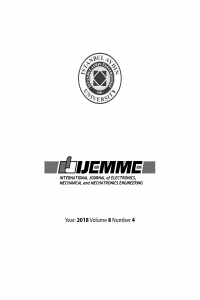Comparing the Performance of ABC Algorithm and ACO Algorithm for Mobile Robot Path Planning in Dynamic Environments with Different Complexities
Abstract
Mobile robot path planning is an important branch of research in robotics science. in this paper, a new approach for
solving mobile robot path planning in dynamic environments, based on the Swarm Intelligence Algorithms feature of an optimized
ABC algorithm is proposed. The proposed ABC will optimize the fuzzy rules’ parameters that have been used for On-line path
planning in dynamic environments. In this study, there is a proposed evaluation function, accordingly, the found path is smoother
and cleaner than the previous studies using other algorithms. In this research, the ABC and ACO are combined with fuzzy logic;
two algorithms are compared with each other. The performance of both combined algorithms in the execution speed and the number
of occurrences for obtaining the optimal path in various unknown environments have been evaluated using MATLAB simulation
methods. The obtained results from the comparison of the performance of these two algorithms developed optimization algorithms
for mobile robots’ path planning.
References
- [1] G. Eason, B. Noble, and I.N. Sneddon, “On certain integrals of Lipschitz-Hankel type involving products of Bessel functions,” Phil. Trans. Roy. Soc. London, vol. A247, pp. 529-551, April 1955.
- [2] J. Clerk Maxwell, A Treatise on Electricity and Magnetism, 3rd ed., vol. 2. Oxford: Clarendon, 1892, pp.68-73.
- [3] I.S. Jacobs and C.P. Bean, “Fine particles, thin films and exchange anisotropy,” in Magnetism, vol. III, G.T. Rado and H. Suhl, Eds. New York: Academic, 1963, pp. 271-350.
- [4] K. Elissa, “Title of paper if known,” unpublished.
- [5] R. Nicole, “Title of paper with only first word capitalized,” J. Name Stand. Abbrev., in press.
- [6] Y. Yorozu, M. Hirano, K. Oka, and Y. Tagawa, “Electron spectroscopy studies on magneto-optical media and plastic substrate interface,” IEEE Transl. J. Magn. Japan, vol. 2, pp. 740-741, August 1987 [Digests 9th Annual Conf. Magnetics Japan, p. 301, 1982.
- [7] M. Young, The Technical Writer’s Handbook. Mill Valley, CA: University Science, 1989.
- [8] D. Xin and C. Hua-hua, "Neural network and genetic algorithm basedglobal path planning in a static environment", Journal of Zhejiang University SCIENCE, 6 A(6):549-554, 2005.
- [9] Z.S. Yang. "Nature-inspired metaheuristic algorithms", Luniver press, 2011.
- [10] H. DongbingGu, “A Differential Game Approach to FormationControl” IEEE Transactions On Control Systems Technology, Vol. 16, No. 1, January 2008.
- [11] Yanyan Dai, Viet-Hong Tran, ZhiguangXu, and Suk-Gyu Lee"Leader-Follower Formation Control of Multirobots by using a stable Tracking Control Method', ICSI 2010, Part II, LNCS 6146, pp. 291–298,2010.
- [12] SitiNurmaini,AngginaPrimanita “Modeling of Mobile Robot System with Control Strategy Based on Type-2 Fuzzy Logic”International Journal of Information and Communication Technology Research, Volume 2 No. 3, March 2012.
- [13] M.A. Porta Garcia, O. Montiel, O. Castillo, R. Sepu´ lveda, P. Melin, "Path planning for autonomous mobile robot navigation with ant colonyoptimization and fuzzy cost function evaluation", Applied soft computingElsevier of journal, 1102-1110, 2009.
- [14] P.Mellodge. "Model Abstraction in Dynamical Systems: Application to Mobile Robot Control", Thesis, Virginia Polytechnic Institute and State University, Blacksburg, Virginia, May 10, 2007.
- [15] O. Castillo and L. Trujillo, "Multiple Objective Optimization Genetic Algorithms for Path Planning in Autonomous Mobile Robots",International Journal of Computers, Systems and Signals, Vol. 6, No. 1, 2005.
- [16] D. Huh, J, Park, U. Huh, H. Kim, “Path Planning and Navigation for Autonomous Mobile Robot,” IECON 02 IEEE annual conference, 2010.
- [17] M. Mohamad, W. Dunningan, Ant colony robot motion planning, in: The International Conference on Computer as a Tool, EUROCON, Serbia & Montenegro, pp. 213–216, 2005.
- [18] O. Ob e, I. Dumitrache”AdaptiveNeuro-Fuzzy Controler With Genetic Training For Mobile Robot Control” Int. J. of Computers,Communications & Control, ISSN 1841-9836, E-ISSN 1841-9844 Vol. VII (2012), No. 1 (March), pp. 135-146.
- [19] W. Kwong and Y. Xu, "A Generalized 3-D Path Planning Method for Robots Using Genetic Algorithm with an Adaptive Evolution Process",Proceedings of the 8th World Congress on Intelligent Control and Automation July 6-9 2010, Jinan, China.
- [20] F. khosravipurian, F. farokhi, R. sabbaghi, "Comparing the performance of genetic algorithm and ant colony optimization algorithm for mobile robot path planning in the dynamic environments with different complexities", Journal of Academic and Applied Studies (JAAS) Int. Association for Academies, Canada, Vol.3, No.2, Feb 2013, ISSN: 1925-931x.
- [21] F. khosravipurian, E. sadeghian, "Path planning of mobile robots via fuzzy logic in unknown dynamic environments with different complexities", Journal of Basic and Applied Scientific Research, J. Basic. Appl. sci. Res, 3(2s), 528-535, 2013.
Details
| Primary Language | English |
|---|---|
| Subjects | Engineering |
| Journal Section | Articles |
| Authors | |
| Publication Date | October 1, 2018 |
| Published in Issue | Year 2018 Volume: 8 Issue: 4 |

